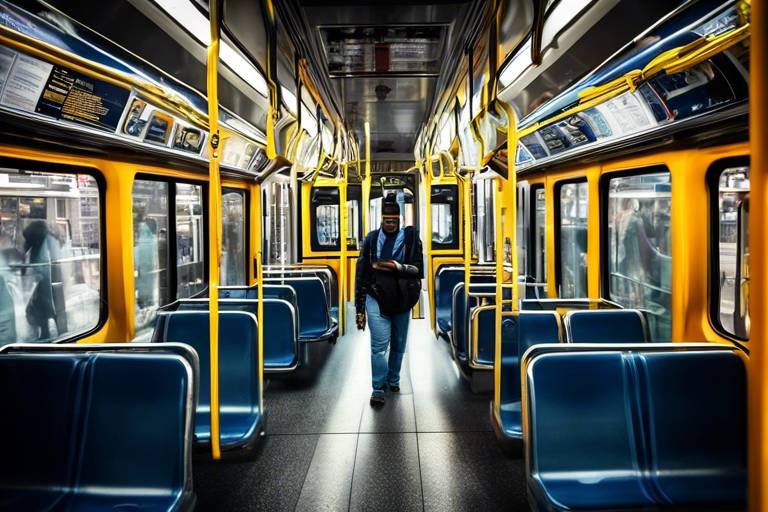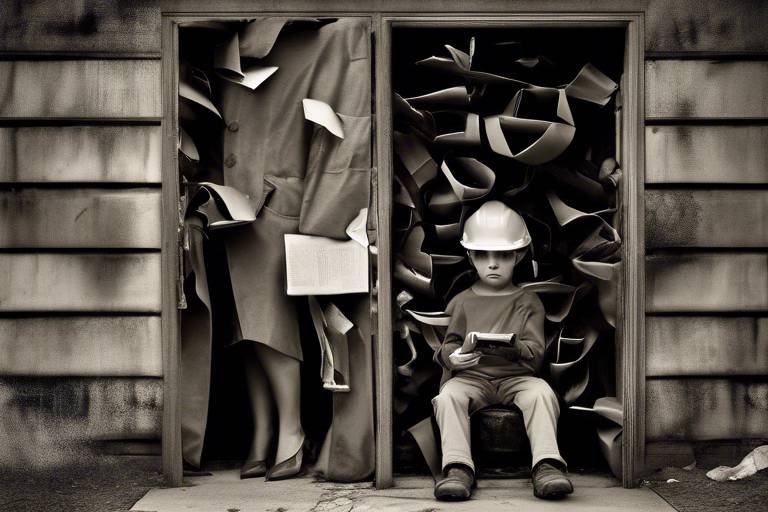Road Crossing Safety: Tips for Pedestrians
Crossing the road may seem like a simple task, but it can be a daunting challenge for many pedestrians. Every year, countless accidents occur due to a lack of awareness and understanding of road safety. Whether you're a seasoned city dweller or a casual walker, it's crucial to prioritize your safety while navigating the bustling streets. In this article, we will explore essential tips that will help you enhance your safety while crossing roads, highlighting best practices, common hazards, and the importance of being aware of your surroundings. So, let’s dive in and ensure that every step you take is a safe one!
Familiarizing yourself with road signs is crucial for pedestrian safety. These signs serve as your guide, helping you navigate through busy intersections and ensuring you make informed decisions. For instance, a pedestrian crossing sign indicates that you are approaching a designated area where it's safer to cross. Similarly, traffic signals provide essential information about when to stop and when to go. Understanding these signs can significantly reduce the risk of accidents. Always keep an eye out for signs like:
- Yield to Pedestrians - This sign reminds drivers to give way to pedestrians in crosswalks.
- Stop Sign - A clear indication that vehicles must come to a complete stop, allowing pedestrians to cross safely.
- No Turn on Red - This sign is crucial for pedestrians as it prevents turning vehicles from entering the crosswalk unexpectedly.
Identifying safe places to cross the road is vital for your safety. Always opt for designated crosswalks, as they are specifically designed to protect pedestrians. Additionally, traffic lights serve as crucial indicators of when it's safe to cross. When you approach an intersection, look for these safe crossing points:
- Marked Crosswalks - Always use these whenever available.
- Traffic Signals - Wait for the green pedestrian signal before proceeding.
- Pedestrian Overpasses or Underpasses - These structures allow you to cross busy roads without the risk of oncoming traffic.
Crosswalks are designed for pedestrian safety, but using them effectively is key. Always wait for traffic to stop before stepping onto the road. Make eye contact with drivers whenever possible; this simple act can significantly increase your safety. Remember, just because you are in a crosswalk does not guarantee that vehicles will stop. Always be vigilant and prepared to react if a driver does not see you.
Understanding traffic signals is essential for pedestrians. The green pedestrian signal is your cue to cross, but it’s important to recognize that this signal does not mean you are automatically safe. Always look both ways before stepping off the curb. If the signal changes while you are crossing, continue to walk briskly to the other side—don’t run, as this can lead to accidents.
Before stepping onto the road, checking for turning vehicles is crucial. Many accidents occur at intersections because pedestrians fail to notice cars turning right or left. Always be vigilant and look for vehicles that may not be stopping, especially at intersections where visibility might be limited. A quick glance can save your life!
Distractions can lead to dangerous situations. In today’s fast-paced world, it’s easy to get sidetracked by your phone or other distractions. However, staying alert while crossing is paramount. Avoid using your phone, listening to music, or engaging in activities that take your focus away from the road. Being aware of your surroundings allows you to react quickly to any potential hazards, keeping you safe as you navigate the streets.
Teaching children about road safety is essential for their protection. Kids often lack the awareness needed to navigate roads safely, making it crucial for parents to step in. Start by explaining the importance of using crosswalks and looking both ways before crossing. Use simple language and relatable examples to make the lessons stick.
Practicing crossing scenarios can help children learn effectively. Set up a mock crosswalk in a safe area and take turns acting as pedestrians and drivers. This interactive approach reinforces safe crossing behaviors in a controlled environment, helping children understand the importance of road safety in a fun and engaging way.
Developing good habits early on is critical. Encourage your children to always hold your hand when crossing the street and to wait for you to signal when it's safe to go. Consistently practicing these habits will instill a sense of responsibility and awareness in them, ensuring they remain safe as they grow.
Q: What should I do if there are no crosswalks available?
A: If there are no crosswalks, look for a straight section of the road with good visibility. Cross at a point where you can see and be seen by drivers, and always be cautious.
Q: How can I teach my child to be safe while crossing the street?
A: Use role-playing scenarios to practice safe crossing techniques, and always emphasize the importance of looking both ways before crossing.
Q: What should I do if a driver doesn’t stop for me at a crosswalk?
A: If a driver does not yield, do not cross the street. Wait until it is safe, and consider reporting the driver if necessary.

Understanding Road Signs
When it comes to pedestrian safety, is like having a map in a foreign land. Just as a map guides you through unfamiliar territory, road signs help you navigate the bustling streets, ensuring you know where it's safe to cross and what dangers may lie ahead. These signs are not just mere decorations; they serve a critical purpose in maintaining order and safety on the roads.
First and foremost, let’s talk about the signs that indicate crossing areas. Look for pedestrian crossing signs, which often feature a symbol of a person walking. These signs are your green light to approach a crosswalk. Additionally, traffic signals play a vital role in pedestrian safety. The familiar red, yellow, and green lights not only govern vehicle movement but also dictate when it’s safe for you to step onto the road. Understanding these signals can be the difference between a safe crossing and a potential accident.
Moreover, it’s essential to recognize the significance of flashing signals at some intersections. These signals act as a warning for both drivers and pedestrians, indicating that a crosswalk is nearby and that you should be extra cautious. When you see a flashing pedestrian signal, it’s a clear sign to prepare to cross but also to be vigilant, as vehicles may still be in motion.
To further enhance your understanding, let's take a look at a few common road signs that every pedestrian should be aware of:
| Sign Type | Description |
|---|---|
| Pedestrian Crossing | A sign indicating a designated area for pedestrians to cross the road safely. |
| Stop Sign | A sign that requires vehicles to come to a complete stop, giving pedestrians the right of way. |
| Yield Sign | A sign indicating that vehicles must yield to pedestrians in the crosswalk. |
| No Turn on Red | A sign that prohibits vehicles from turning right while the traffic signal is red, ensuring pedestrian safety. |
In addition to these signs, being aware of road markings is equally important. Marked crosswalks, often painted with bold white stripes, are your safest bet for crossing the street. They signal to drivers that they must be on the lookout for pedestrians. However, don’t assume that every driver will see you; always make eye contact with them before stepping off the curb.
Lastly, let’s not forget about the importance of situational awareness. As a pedestrian, you should always be on the lookout for any signs that indicate potential hazards. For instance, if you see a sign indicating a school zone, be extra cautious, as children may be crossing or playing nearby. Understanding road signs is not just about reading them; it’s about interpreting their meaning and responding appropriately to ensure your safety.
In conclusion, being well-versed in road signs is an essential skill for every pedestrian. By recognizing and understanding these signs, you can enhance your safety and navigate the roads with confidence. So next time you’re out and about, take a moment to look around and familiarize yourself with the signs that govern the streets. After all, knowledge is power, especially when it comes to keeping yourself safe!

Choosing Safe Crossing Locations
When it comes to pedestrian safety, knowing where to cross the road can make all the difference. Imagine you’re standing at a busy intersection, cars whizzing by, and you need to get to the other side. It's not just about making a dash for it; it's about choosing the right spot to cross. Designated crosswalks, traffic signals, and pedestrian bridges are your best friends in this journey. They are specifically created to keep you safe, guiding you through the chaos of traffic.
First off, let’s talk about designated crosswalks. These are marked areas on the road where pedestrians are allowed to cross. They often come with painted lines and sometimes even signals to let you know when it’s safe to step off the curb. Using these crosswalks is crucial because they alert drivers to expect pedestrians. Think of it as a traffic dance where everyone knows their steps. If you step outside of this designated area, you’re not just putting yourself at risk, but you’re also throwing off the rhythm of that dance. Drivers may not be looking for pedestrians in unexpected places, and that’s when accidents happen.
Next up, let’s discuss the importance of traffic lights. These little signals are more than just colorful lights; they are your signal to cross safely. Always wait for the green pedestrian signal before stepping off the curb. It’s like waiting for the green light in a game of red light, green light—except this time, it’s your safety on the line! Understanding when to cross can prevent you from becoming a statistic. You wouldn’t jump into a game without knowing the rules, right? The same goes for crossing streets.
Now, if you find yourself at an intersection without a crosswalk, it’s crucial to look for other safe crossing points. Pedestrian bridges and tunnels are fantastic options that keep you away from the traffic altogether. Just picture yourself walking above the hustle and bustle, feeling like you’re in a superhero movie where you can avoid all the danger below. These structures are built for your protection, so take advantage of them whenever you can!
But what about those moments when you have to cross at a non-designated area? Here’s where your vigilance comes into play. Always check for oncoming traffic and be aware of the road conditions. If you see cars turning at intersections, be extra cautious. You might think they see you, but often, they’re focused on their own path. Make eye contact with drivers whenever possible; it’s like saying, “Hey, I’m here, and I’m crossing!” This simple act can significantly reduce the chances of an accident.
In summary, choosing safe crossing locations is not just a matter of convenience; it’s a critical aspect of pedestrian safety. By sticking to designated crosswalks, waiting for traffic signals, and being aware of your surroundings, you can navigate the streets with confidence. Remember, safety is not just about knowing where to cross; it’s about being smart and aware of the environment around you. So next time you’re out and about, take a moment to assess your crossing options. Your life could depend on it!

Using Crosswalks Effectively
Crosswalks are not just painted lines on the road; they are your safe passageways designed specifically for pedestrians. When you step onto a crosswalk, it’s like entering a zone of protection, but only if you use it wisely. First and foremost, always wait for traffic to stop before you begin to cross. This is crucial because even if you're at a crosswalk, some drivers may not notice you until it's too late. Making eye contact with drivers is a simple yet effective way to ensure they see you. It’s like a silent agreement: you see them, they see you, and everyone knows it’s time to play nice on the road.
Now, let’s talk about the importance of observing your surroundings. Before stepping off the curb, take a moment to look left, right, and then left again. This isn’t just a childhood rhyme; it’s a habit that can save your life. You might think you’re safe because you’re in a crosswalk, but remember, not all vehicles stop as they should. Some may be turning, and they might not be looking out for you. In fact, according to statistics, a significant number of pedestrian accidents occur at crosswalks due to inattentive drivers.
Additionally, if you’re crossing at a traffic light, ensure you’re waiting for the green pedestrian signal. This signal is your friend, signaling that it’s your turn to cross safely. But don’t just rely on the signal; always double-check for any vehicles that might be turning. Just because the light is green for you doesn’t mean it’s green for everyone else. It’s like being in a dance where you have to stay in sync with the rhythm of the road!
Lastly, if you notice a crosswalk that seems to be poorly marked or in disrepair, report it to local authorities. Safe crossing should be a right, not a privilege, and you can help make your community safer by advocating for better pedestrian infrastructure. Remember, using crosswalks effectively is not just about following rules; it’s about staying alive and being smart on the road.
- What should I do if there are no crosswalks available? If you find yourself in a situation without a crosswalk, look for a safe place to cross, ideally at an intersection where you can see traffic coming from all directions.
- Are crosswalks always safe? While crosswalks are designed for safety, it’s essential to remain vigilant and aware of your surroundings, as not all drivers may yield to pedestrians.
- How can I teach my children to use crosswalks safely? Role-playing scenarios and practicing crossing together can help children understand the importance of waiting for traffic to stop and looking both ways.

Waiting for the Signal
When it comes to crossing the road, understanding traffic signals is not just a good idea; it's a vital part of pedestrian safety. Imagine standing at a busy intersection, the hustle and bustle of cars zooming by, and you're eager to get to the other side. It’s easy to feel a bit impatient, but waiting for the pedestrian signal can make all the difference. The green pedestrian signal is like a green light for your safety—it’s your cue to move forward with confidence.
It's essential to recognize the importance of these signals. They are designed to manage the flow of both vehicle and pedestrian traffic, ensuring that everyone can navigate safely. When the pedestrian signal is green, it means that vehicles are required to stop, allowing you to cross the street safely. However, just because the light is green doesn't mean you should rush across without a second thought. Always take a moment to look around; make sure that vehicles are indeed stopping for you. After all, a driver might be distracted or in a hurry, and you don’t want to be caught off guard.
Moreover, it's crucial to understand the different signals. For instance, a flashing pedestrian signal often indicates that you should hurry across the street. But what if it’s red? In that case, it’s a clear sign to stay put. Never underestimate the power of a red signal—it’s there to protect you. Additionally, some intersections have countdown timers that show how many seconds you have left to cross. This can help you gauge whether you have enough time to make it safely to the other side.
Here's a quick overview of common traffic signals you might encounter:
| Signal Type | Meaning |
|---|---|
| Green Pedestrian Signal | Safe to cross |
| Red Pedestrian Signal | Do not cross |
| Flashing Signal | Hurry, time is running out |
| Countdown Timer | Indicates remaining time to cross |
In addition to waiting for the signal, it’s equally important to teach children about the significance of these signals. Children are often eager to cross the street, but they may not fully understand the implications of ignoring a red light. Educating them on this aspect can prevent accidents and instill a sense of responsibility regarding their safety.
So, the next time you find yourself at a crosswalk, take a deep breath and remind yourself: patience is key. Waiting for the signal isn’t just about adhering to traffic laws; it’s about ensuring your safety and the safety of those around you. In a world where distractions are everywhere, taking that extra moment to assess your surroundings can be the difference between a safe crossing and a dangerous situation.
- What should I do if the pedestrian signal is not working? If the signal is malfunctioning, look for traffic and cross only when it is safe to do so.
- Can I cross the street when the pedestrian signal is red? No, crossing during a red pedestrian signal is against traffic rules and can be dangerous.
- How can I teach my child about traffic signals? Use role-playing and practice crossing at safe intersections to reinforce understanding.
- Are there any apps that can help with pedestrian safety? Yes, there are several apps designed to alert pedestrians about traffic signals and conditions.

Checking for Turning Vehicles
When you're about to cross the street, one of the most critical steps you can take is to check for turning vehicles. It might seem like a no-brainer, but this simple act can be the difference between a safe crossing and a potential accident. Imagine standing at the edge of the sidewalk, ready to take that first step onto the road, and suddenly, a car whizzes by, turning right where you were about to walk. Scary, right? That's why being vigilant is essential.
Before you even think about stepping off the curb, take a moment to scan the intersection. Look left, right, and then left again. This way, you can catch any vehicles that may be approaching from different directions. Don’t just rely on your ears; many cars are surprisingly quiet, especially electric ones. Make it a habit to always make eye contact with drivers whenever possible. If a driver sees you and acknowledges your presence, it's a good sign that they are aware of you and are likely to stop.
It's also important to be aware of the common scenarios where turning vehicles pose a risk:
- Right turns at intersections, especially when the light is green.
- Left turns across pedestrian crosswalks.
- Drivers who may not be fully paying attention, such as those distracted by their phones.
Moreover, keep an eye out for turning signals. If you see a vehicle with its turn signal on, be extra cautious. Just because they are signaling doesn’t always mean they will yield to pedestrians. Remember, they might be focused on the road ahead and not notice you waiting to cross. In these situations, never assume that a driver will stop for you. Always be prepared to take a step back if a vehicle is approaching.
Lastly, don’t forget about blind spots. Larger vehicles like buses and trucks can obstruct your view of smaller cars. If you’re standing behind one of these vehicles, you might not see a car coming until it’s too late. Always position yourself where you can see clearly and where drivers can see you. In essence, being proactive and aware can drastically reduce the risk of accidents and ensure a safe crossing.

Staying Alert While Crossing
When it comes to crossing roads, staying alert is your best defense against accidents. Imagine you're a deer in the woods—calm, aware, and ready to react at a moment's notice. The streets can be just as unpredictable, filled with vehicles that seem to appear out of nowhere. To enhance your safety while crossing, it’s essential to be fully present and engaged with your surroundings. This means putting away distractions like your phone and focusing on the task at hand. After all, that text message can wait, but your safety cannot!
One of the biggest distractions today is our smartphones. It's tempting to check your notifications or scroll through social media while waiting to cross, but this can lead to dangerous situations. When you're glued to your screen, you might miss a vehicle that’s speeding towards you or a cyclist weaving through traffic. A good rule of thumb is to keep your phone in your pocket until you're safely on the other side of the street. Think of it as a moment of mindfulness—taking a brief pause to appreciate the world around you before stepping into it.
Being aware of your surroundings also means listening as much as seeing. Sounds can provide valuable information about what's happening around you. For instance, the revving of an engine or the sound of brakes can alert you to a vehicle that may not be visible yet. So, when you’re preparing to cross, take a moment to tune into the sounds of the street. Are there any vehicles approaching? Is there a sudden silence that might indicate a car is slowing down? These auditory cues can help you make better decisions.
Moreover, make it a habit to make eye contact with drivers whenever possible. This simple act can communicate your intention to cross and ensure that the driver sees you. It’s like a silent handshake—a mutual acknowledgment that keeps everyone aware of each other's presence. Remember, just because you have the right of way doesn’t mean that every driver will yield to you. Always be prepared to stop if necessary, even if you’re in a crosswalk.
Finally, consider the weather conditions. Rain, snow, or fog can significantly reduce visibility for both pedestrians and drivers. If the weather is bad, take extra precautions. Slow down, and ensure that you’re clearly visible. Wearing bright or reflective clothing can make a huge difference, especially in low-light conditions. Just like a lighthouse guides ships safely to shore, being visible can guide drivers to you, preventing potential accidents.
In summary, staying alert while crossing the road involves a combination of awareness, mindfulness, and communication. By eliminating distractions, listening for sounds, making eye contact with drivers, and dressing appropriately for the weather, you can significantly enhance your safety. Always remember, your safety is in your hands—so stay sharp and cross smart!
- What should I do if I see a vehicle approaching while I'm in a crosswalk?
Always stop and wait for the vehicle to pass, even if you have the right of way. Safety first! - Is it safe to cross while using headphones?
No, using headphones can distract you from your surroundings and make it harder to hear approaching vehicles. - How can I teach my children to stay alert while crossing?
Engage them in discussions about road safety and practice crossing together, reinforcing the importance of being aware of their surroundings.

Educating Children on Safety
Teaching children about road safety is not just a good idea; it's a necessity. Children are naturally curious and often unaware of the dangers that lurk on the streets. By instilling safe crossing practices early, you can help them navigate their environments with confidence and awareness. Imagine your child as a little explorer, venturing out into the world, and you want them to be equipped with the right tools to stay safe. So, how do you go about this important task?
First and foremost, communication is key. Talk to your children about the rules of the road and why they exist. Use simple language and relatable examples to explain concepts like traffic signals, crosswalks, and the importance of looking both ways before crossing. You might say, "Just like how we wait for the green light when playing a game, we wait for the green pedestrian signal to cross the street." This analogy helps them understand the importance of patience and awareness.
One effective method to teach road safety is through role-playing scenarios. Set up a mock street in your backyard or living room, complete with makeshift traffic signals and crosswalks. Allow your child to practice crossing the street safely, waiting for signals, and looking for cars. This hands-on approach makes learning fun and memorable. You might even enlist the help of siblings or friends to create a more realistic environment, turning the lesson into a playful adventure.
Additionally, instilling good habits early on is critical. Encourage your children to always use crosswalks and to be aware of their surroundings. Explain that they should never assume a driver sees them, even if they are standing at a crosswalk. You could say, "Always make eye contact with drivers before you step onto the road. It's like saying, 'Hey, I see you, and I’m about to cross!'” This simple practice can significantly reduce the risk of accidents.
Moreover, consider creating a road safety checklist that your children can refer to before leaving the house. This could include reminders like:
- Look left, right, and left again before crossing.
- Always use crosswalks and pedestrian signals.
- Stay alert and avoid distractions, like using a phone.
- Wear bright or reflective clothing to be seen better.
By making it a part of their routine, you are reinforcing these essential habits. Over time, these practices will become second nature to them, just like brushing their teeth or washing their hands. Remember, the goal is to create a culture of safety that your children will carry with them as they grow.
Lastly, don’t forget to lead by example. Children learn a lot by observing their parents. If they see you adhering to road safety rules, they are more likely to follow suit. So, whether you’re waiting for the light to change or using crosswalks, make sure your actions reflect the teachings you impart. It’s all about creating a safe environment where children feel empowered to make smart decisions on the road.
Q: At what age should I start teaching my child about road safety?
A: It's never too early to start! You can begin introducing basic concepts as soon as your child starts walking. As they grow older, you can expand on these lessons with more details about traffic rules.
Q: How can I make road safety lessons fun?
A: Incorporate games and role-playing into your lessons. Create a mock street setup at home, or use fun activities like drawing traffic signs to engage your child in learning.
Q: What should I do if my child refuses to listen to road safety rules?
A: Be patient and consistent. Use positive reinforcement to encourage good behavior and remind them of the importance of safety. Sharing stories or examples of accidents can also help them understand the seriousness of the issue.

Role-Playing Scenarios
When it comes to teaching children about road safety, can be incredibly effective. Imagine this: instead of just telling your child to look both ways before crossing, you create a mini road setup in your backyard or living room. You can use toy cars and even draw a crosswalk on the ground with chalk or tape. This interactive approach not only makes learning fun but also helps them visualize real-life situations where they need to apply their knowledge. By acting out different scenarios, children can practice what they've learned in a safe environment, which boosts their confidence and makes the lessons stick.
For instance, you could set up a scenario where they have to wait at a crosswalk. Have them role-play as both the pedestrian and the driver. This way, they can experience what it feels like to be in both positions. They’ll learn the importance of waiting for the green pedestrian signal and how crucial it is to make eye contact with drivers. You could even introduce unexpected elements, like a car that doesn't stop, to teach them how to react in real-life situations. This method not only reinforces their understanding but also prepares them to handle potential dangers.
Additionally, you can create a checklist of safe crossing behaviors that they can refer to during these role-playing exercises. Here’s an example of what that checklist might include:
| Safe Crossing Behaviors |
|---|
| Look left, right, and left again before crossing. |
| Only cross at designated crosswalks. |
| Wait for the green pedestrian signal. |
| Make eye contact with drivers. |
| Stay alert and avoid distractions. |
By incorporating these role-playing scenarios into your routine, you not only make learning about road safety engaging but also equip your child with the skills they need to navigate the streets confidently. Remember, the goal is to create a safe space for them to learn and ask questions, so encourage them to express any fears or uncertainties they may have. This open dialogue will foster a deeper understanding of pedestrian safety, ensuring they carry these lessons with them as they grow.
- What age should I start teaching my child about road safety? It's advisable to start teaching children about road safety as early as age 4 or 5, gradually increasing the complexity of the lessons as they grow.
- How can I make road safety lessons fun? Use games, role-playing, and interactive activities like creating a mini road setup to make learning enjoyable for your child.
- What should I do if my child is scared to cross the road? Take the time to practice crossing in safe environments, and reassure them by discussing their fears and providing positive reinforcement.
- Are there any apps or resources available for teaching road safety? Yes, there are several educational apps and websites dedicated to teaching children about road safety through games and interactive lessons.

Instilling Good Habits
Instilling good habits in children regarding road safety is like planting a seed that will grow into a strong tree. The earlier you start, the deeper the roots of awareness and caution will be. Parents play a pivotal role in shaping these habits, and it can be as simple as incorporating safety discussions into daily routines. For instance, every time you walk together, seize the moment to engage your child in a conversation about what to look for when crossing the road. This not only reinforces their learning but also makes them feel involved and responsible.
One effective method is to create a consistent routine around road safety. You can designate a specific day of the week to practice crossing the street together, making it a fun and engaging activity. This could be a weekly “safety walk” where you explore different routes and identify safe crossing points. By doing this regularly, you help your child develop a natural instinct for safety. Encourage them to look for crosswalks, traffic lights, and other pedestrian signals, reinforcing the idea that these are their allies in ensuring safe crossings.
Additionally, role-playing scenarios can be incredibly beneficial. You can set up a mock street in your backyard or living room using household items to simulate traffic signs and crosswalks. Take turns being the pedestrian and the driver, allowing your child to experience both perspectives. This hands-on approach not only makes learning fun but also helps them understand the importance of being vigilant. You can ask questions like, "What do you think the driver sees?" or "How can we make sure it's safe to cross?" These prompts encourage critical thinking and awareness.
Another crucial aspect is to lead by example. Children are keen observers and often mimic the behavior of adults. If they see you consistently following traffic rules, they are more likely to adopt similar habits. Always remember to look both ways before crossing, use crosswalks, and wait for the pedestrian signal. By demonstrating these behaviors, you're not just telling them what to do; you're showing them how to do it. It’s the old adage of “show, don’t tell” in action!
Lastly, consider discussing the consequences of unsafe behavior in an age-appropriate manner. While it’s important not to scare them, explaining the potential dangers of not paying attention can help them understand the gravity of road safety. You might say something like, “If we don’t look both ways, we might not see a car coming, and that could hurt us.” This approach fosters a sense of responsibility and encourages them to be proactive about their safety.
- What age should I start teaching my child about road safety?
It's ideal to start teaching road safety as soon as your child begins walking. Incorporate safety discussions into your daily routine. - How can I make learning about road safety fun?
Use games, role-playing scenarios, and safety walks to make the learning process engaging and enjoyable. - What should I do if my child refuses to follow safety rules?
Stay calm and explain the importance of safety in simple terms. Reinforce positive behavior with praise when they do follow the rules.
Frequently Asked Questions
- What are the most important road signs for pedestrians to know?
Understanding road signs is key to pedestrian safety. Some essential signs include pedestrian crossing signs, which indicate where it's safe to cross, and traffic signals that show when to stop and go. Familiarizing yourself with these signs can help you navigate streets more safely.
- How can I identify safe places to cross the road?
Always look for designated crosswalks, traffic lights, or pedestrian bridges. These areas are specifically designed to keep you safe. Remember, crossing at these points significantly reduces your risk of accidents compared to jaywalking or crossing at unmarked locations.
- What should I do while waiting to cross at a traffic signal?
While waiting, make sure to watch the traffic lights and wait for the green pedestrian signal. It's also wise to make eye contact with drivers to ensure they see you before you step onto the road. This simple act can greatly enhance your safety.
- How can I stay alert while crossing the street?
Distractions can be dangerous! Avoid using your phone and keep your head up. Look around and listen for any vehicles that might be approaching. Staying aware of your surroundings is crucial for safe crossing.
- What tips can I give my children about road safety?
Start by teaching them the importance of using crosswalks and waiting for traffic signals. Role-playing crossing scenarios can also help them learn effectively. Instilling these habits early on ensures they understand how to stay safe as they grow.
- How can I instill good pedestrian habits in my children?
Model safe behavior yourself and engage in regular discussions about road safety. Encourage them to practice safe crossing techniques, and reward them for making good choices. This reinforcement helps them develop lifelong pedestrian safety habits.



















